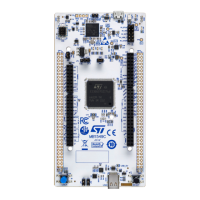6.6 Push-buttons
Two buttons are available on the Nucleo board.
B1 USER button
The blue button for user and wake‑up functions is connected to PC13 to support the default TAMPER function
or to PA0 to support the optional wake‑up function of the STM32 Microcontroller. When the button is pressed the
logic state is HIGH, otherwise, the logic state is LOW.
• To connect the USER button to PC13, the solder bridge SB58 must be ON and the SB59 must be OFF. This
is the default configuration.
• To connect the USER button to PA0, the solder bridge SB58 must be OFF and the SB59 must be ON. This
is the optional configuration.
B2 RESET button
The black button connected to NRST is used to reset the STM32 microcontroller. When the button is pressed the
logic state is LOW, otherwise, the logic state is HIGH.
The blue and black plastic hats placed on these push‑buttons can be removed if necessary when a shield
or an application board is plugged on the top of the Nucleo board. This avoids pressure on the buttons and
consequently a possible permanent target MCU reset.
6.7 OSC clock sources
Three clock sources are described below:
• LSE is the 32.768 kHz crystal for the STM32 embedded RTC.
• MCO is the 8 MHz clock from STLINK-V3E MCU for the STM32 microcontroller.
• HSE is the 16 MHz oscillator for the STM32 microcontroller. This clock is not implemented in a basic
configuration.
6.7.1 LSE: OSC 32 KHz clock supply
There are three ways to configure the pins corresponding to the low-speed clock (LSE):
LSE on-board oscillator X2 crystal (Default configuration)
Refer to the application note Oscillator design guide for STM8AF/AL/S, STM32 MCUs and MPUs
(AN2867), with the following characteristics: 32.768 kHz, 9 pF, 20 ppm. It is recommended to use
NX1610SE‑ 32.768KHZ‑EXS00A‑ MU01499 manufactured by NDK. The following configuration is needed:
• R32 and R33 ON
• SB51 and SB52 OFF
Oscillator from external to PC14
From external oscillator through PC14, CN11 connector pin 25. The following configuration is needed:
• R32 and R33 OFF
• SB51 and SB52 ON, for connection from CN11 Zio connector pin 25
LSE not used
PC14 and PC15 are used as GPIOs instead of low‑speed clocks. The following configuration is needed:
• R32 and R33 OFF
• SB51 and SB52 ON
UM2861
Push-buttons
UM2861 - Rev 2
page 26/49

